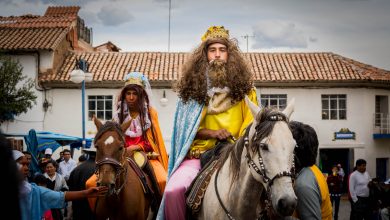The Power of Young Men, the Caporal

Bells jangle and boots slap as young men in bright colored costumes aggressively and yet with control dance up the street. A show of testosterone and maleness it pulls young men in and makes them want to display their abilities.
This is the caporal, one of the more popular dances in highlands. It originated in La Paz, Bolivia out of the tradition of Afro-Bolivian dances and has spread widely. Last night Cusco, to the frustration of many who prefer their own dances, saw troupe after troupe of caporales dance down the Sun Avenue and into the Plaza.
Widely seen as a manifestation of altiplano culture, the high plateau that includes Puno and La Paz, the caporal also draws young Cusqueños too. At its root in Cusco is the settlement of people from the region of Puno in Cusco. Puno, especially its large city of Juliaca, is known as a commercial center. It is a crossroads connecting roads from Arequipa with those that go on to Bolivia and then to Argentina and Brazil.
Puneños have come to Cusco to do commerce, as they have for centuries if not longer. In the Imperial City, they have organized themselves into hermandades, confraternities in markets and elsewhere to give them the support of numbers and organization. At the same time, following the traditions of their land, they represent that corporate existence in dances, and not any dances, but the urban ones that are strongly shaping their region.
In an earlier time they brought the dance now called Qhapaq Colla, one of the classics of Cusco, although in its day it was not accepted. This dance, also called llamerada or llama herders, spoke to the indigenous Colla merchants who came into Cusco from the powerful altiplano bringing goods.

Initially resisted, this dance has become part of the code now. However, it is very different from the caporal that is unsettling Cusco elites and others so much.
The caporal represents the mestizo or cholo bosses who controlled slaves for their Spanish owners. It is a strong and one that has implied violence just below the surface as with aggression and personal strength, kallpa as it is called in Quechua, they kept the seething anger and potential rebellion of the slaves under control.
Of course, no more than two generations ago, many of the young men who today dance as capataces would themselves have been serfs on landed estates, controlled by mestizo or even cholo overseers, often with implied threats of violence.
The uncontrolled power and potential violence of youth is troubling to elites that wish to keep such controlled, at the same time this dance breaks with the indigenist and neo-Inca ideologies at the core of Cusco public culture, including its dances.
Instead of Indian it is mestizo or cholo and instead of cute it is aggressive and powerful. Instead of couples it requires blocks of men and blocks of short-skirted women. It is not tamed like the Majeños or Maqta. A mass of adrenalin filled young men in sexual prime dance with gymnastic precision, eating up the street as if it were theirs to take.
This image of powerful, graceful young men who can display their virility before society, and the group of young women who accompany them is a good part of what draws so many young men to the dance. It fits a dream of self in urban life where they can claim and become.
This is the dance of a cholo “alzao”, the uppity and uprisen cholo who is taking society and taking the world. As a result, it will continue to spread and claim more and more youth, both people from the altiplano and those from Cusco.




